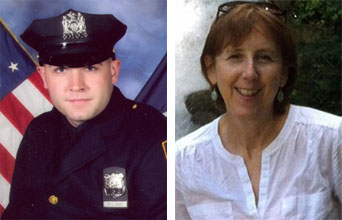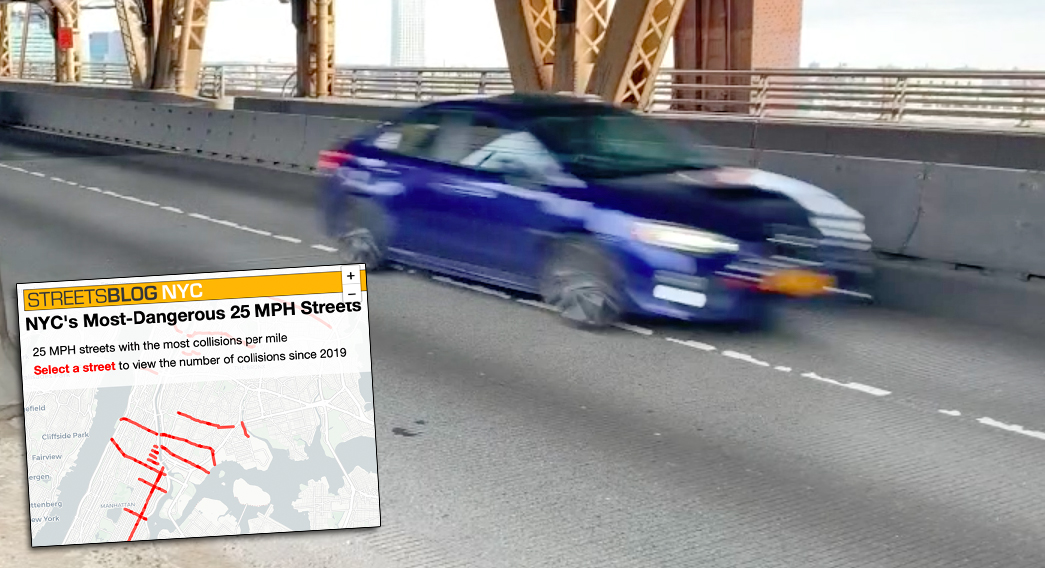On the surface, the crashes that killed Jill Tarlov and Michael Williams last month could hardly have been more different.

Williams, a 25-year-old rookie cop, was riding in an NYPD van on the Bruckner Expressway shortly after dawn en route to police the Peoples Climate March, when the driver of the van crashed into a concrete median. Tarlov, a 58-year-old mother of two from Fairfield, CT, was walking across Central Park around 4:30 p.m. after a day of birthday shopping for her son, when she was struck by a man cycling on the Park Loop.
A young man at work, a middle-aged woman on a stroll. A passenger in a van, a walker in a park. A wet expressway in early morning, a dry park road on a bright afternoon. Miles and worlds apart, but for the awful suddenness and seeming randomness of their deaths, and the grief left in their wakes.
And this too: excessive speed almost certainly played a part — perhaps the key part — in the crashes that killed them both.
Although Tarlov died of brain trauma from her head striking the pavement, the fact that she was unable to break her fall suggests that the cyclist struck her at high speed.
Williams was thrown from the NYPD van "when the cop driver lost control as he rounded a sharp corner on the rain-slicked Bruckner Expressway in Hunts Point," the Daily News reported, and smashed into the highway median. Needless to say, the Bruckner Expressway does not have sharp corners -- it has curves. The Daily News employed the language of our automobile-centered culture that attempts to conceal the simple fact that the driver was going too fast for the conditions.
By now, the authorities probably know how fast the cyclist and the driver were operating their vehicles. The cyclist who struck Tarlov was widely reported to have been a habitual user of Strava, a mobile app for tracking athletic activity that records real-time speeds via GPS and uploads them continuously from watches and phones to a central database. The NYPD seized the cyclist's phone and thus presumably has access to the data feed with his second-by-second position and velocity as he rode toward Tarlov on the park loop road. As for the NYPD 2009 Ford Econoline that crashed on the Bruckner, it likely had an event data recorder or "black box" recording the van’s speed in the moments immediately preceding the crash, which would be available to the police.
Yet it is now three weeks and counting, and no data has been released about either crash. Of course, the NYPD never releases its collision investigations, even though the public has every right to that data, and keeping it hidden impedes efforts to prevent future tragedies.
The public’s stake in knowing the vehicle speed in the Tarlov crash, the Williams crash, and indeed every serious-injury and fatal crash in New York City is enormous. There simply cannot be informed discussion of operator culpability, roadway design, traffic enforcement, prosecutorial responsibility, and, indeed, road traffic culture and governance, if this most basic and crucial parameter is habitually hidden from the public realm.
This has been all too apparent since Tarlov and Williams were killed.
In the first, the cyclist who killed Tarlov was immediately accused of speeding. The cycling community roundly condemned unsafe operation of bicycles. But in order to effectively advocate for changes to Central Park and its cycling cultures that might prevent future tragedies, we need to know if the cyclist who killed Tarlov was traveling at a speed that is unsafe at any time, or if a graduated speed limit to reflect the varying density of pedestrians in city parks at different places and times would be more appropriate.
Conversely, no one has yet accused the driver in the crash that killed Williams of speeding. Instead, discussions of the crash on the Bruckner have been restricted to the apologetics mentioned above: the "sharp corner," the "rain-slicked" roadway, and least often, the fact that neither Williams nor most of his fellow cops were wearing seatbelts. Again, if we are to advocate for proper retraining of drivers, especially the drivers charged with enforcing the rules of the road intended to save lives, we need to know what role, if any, speeding played in this crash.
If the driver of the NYPD van helped precipitate Williams' death by going too fast, we have a right to know. If enforcement can be retooled to prevent more crashes like the one that killed Jill Tarlov, we have a right to know.
We have the right to know what leads to every consequential crash on our streets. And if NYC is ever going to fulfill Vision Zero, we must know.






